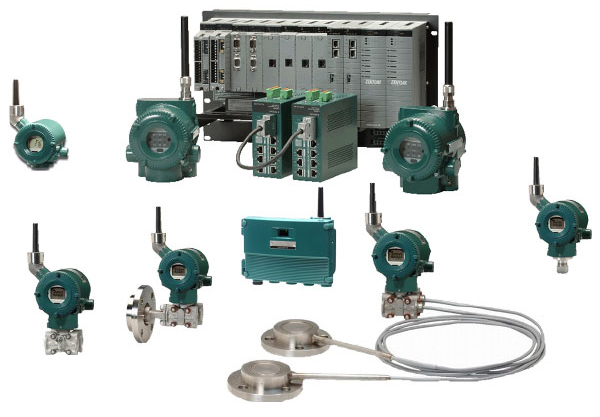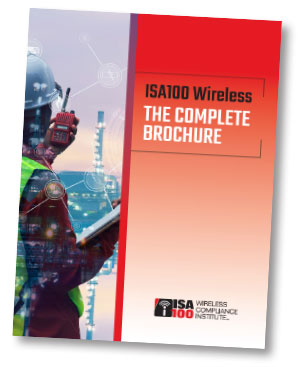- By Jack Smith
- July 03, 2024
- InTech Magazine
- Feature
Summary
Wireless communication facilitates better data analytics, decreased downtime and more autonomous operations, with ISA100 often the best option for industrial applications.

As reported in the August 2023 issue of InTech, the first global end user to use ISA100 wireless technology for real-time oil-field monitoring was Romania-based OMV Petrom, the largest oil and gas producer in Southeast Europe. The project proved interoperability among ISA100 wireless certified devices from multiple technology providers and showed how a company could further its digitalization and production goals with an ISA100 wireless network and instrumentation. Interoperability among the instruments was of vital importance, as was cybersecurity.
OMV Petrom chose ISA100 wireless over other Industrial Internet of Things (IIoT) technologies because it not only met, but exceeded, the requirements for oil field real-time monitoring. Part of the reason is because ISA100 wireless is the only IIoT standards-based solution that can cover a large geographic area using a single wireless mesh, IPv6-addressable network. But industrial plants around the world are choosing ISA100 wireless for other reasons as well: The technology continues to evolve, and certified suppliers are furthering its reach and usefulness with new applications and devices.
In addition, wireless applications are not only trusted but sought after.
“ISA100 can be an important driver for Industry 4.0 and [for] getting stranded data from the edge to main systems. It also gives operators an easy and flexible way of increasing their flexibility to absorb changes in the future,” said Ådne Baer-Olsen, global business development lead for wireless safety at Dräger, one of the world’s largest suppliers of fixed fire and gas detection solutions. “Using wireless gas detection—the application we use ISA100 for—helps [our customers] increase their onsite safety without having to compromise on cost.”
Flint Hills Resources (FHR), another ISA100 wireless user, operates a couple of large refineries, and chemical and fertilizer plants. Robert Boyer, wireless systems administrator at FHR, said, “We use wireless technology for machine learning, stranded data, analytics and more.”
FHR also has a large installation of WirelessHART and LoRa devices. It has used ISA100 technology for about 12 years and the other wireless protocols for about 18 years. According to Boyer, data analytics and decreased downtime are definitely at the top of the list of what wireless technology can help FHR accomplish, “but the real end goal is more autonomous operations and fewer shifts.”
ISA100 evolves
ISA100 wireless, also known as international standard ANSI/ISA-100.11a-2011 (IEC 62743), is a plant-wide wireless infrastructure technology for industrial environments. Its development was led by the International Society of Automation and sprang from a 2002 DOE study revealing the potential benefits of open, standards-based wireless applications at industrial sites.
ISA100 wireless helps make the industrial Internet of Things (IIoT) a reality by being the only industrial wireless protocol to incorporate IPv6 directly as part of its network layer and transport layer. IPv6, which stands for Internet Protocol Version 6, helps to identify and locate devices on the network.
As of 18 August 2023, the next generation of ISA100 wireless field devices began supporting Bluetooth Low Energy (BLE) as a second radio while the established ISA-100 (IEC 62734) protocol could continue to be used for field reporting. BLE enables provisioning and commissioning of ISA100 wireless field devices by Bluetooth-enabled handhelds, particularly mobile phones.
In addition, ISA100 wireless gateways are also adopting a new OPC-UA data model, based on the PA-DIM specification. Developers will be able to build a single set of applications that work end-to-end with all ISA100 wireless systems using the OPC-UA model. These ISA100 wireless enhancements will improve interoperability and the overall user experience.
Certifying for interoperability
The ISA100 Wireless Compliance Institute (WCI) is the body that brings together users, suppliers, and other stakeholders to support adoption of the ISA100 wireless standard. WCI also ensures interoperability of ISA100 wireless devices and systems by:
- conducting independent testing of ISA100 wireless devices and systems
- certifying that ISA100 wireless devices and systems meet specifications
- providing education, tools, and technical support to users and suppliers.
Lists of certified ISA100 wireless devices and suppliers can be found on the ISA100 Wireless Compliance Institute (WCI) website. Dräger has provided products using ISA100 for more than 10 years. (The company also uses both WirelessHART and LoRa wireless communications, but only for monitoring.) “Our ISA100 safe wireless is the only safety-performance-certified wireless solution in the market, giving us a large advantage compared to our competitors,” said Baer-Olsen.
Yokogawa has been involved in the development of the ISA100 standard from the beginning and today provides multiple types of ISA100-compliant products (Figure 1). These include field devices such as temperature, pressure, flow, level, and other transmitters; wireless adapters that can convert analog signals to ISA100 wireless; and gateways and access points. In addition, Yokogawa has developed a unique product with a wireless module inside of an antenna, helping minimize the lead time for ISA100 wireless product development and enhanced product portfolios.

Toshi Hasegawa, senior expert, Marketing Headquarters External Affairs and Marketing Technology Center, for Yokogawa Corporation explained how ISA100 supports both developers and users: “ISA100 wireless is constantly being updated and improved to keep up with the latest technology developments, and it is expanding its application portfolio together with ISA100 WCI member companies.”
ISA100 WCI is developing OPC-UA implementation specifications as a higher-level interface for ISA100 wireless gateway products, supporting more open and secure connectivity. Working with ISA100 WCI member companies, Yokogawa and others can provide multi-vendor solutions with interoperability, allowing customers to choose best-in-class equipment to meet different needs.
Hasegawa said Yokogawa, for example, is:
- Supporting sustainable plant operations by reducing energy losses through monitoring of numerous steam traps on steam pipelines. ISA100 wireless supports numerous device connections and flexible network configurations.
- Ensuring safe and secure plant operations through gas leak detection sensors. ISA100 wireless provides deterministic response and redundant communication with Duo-cast (a redundancy technology for the wireless path specified in the ISA100.11a standard) for these and other critical applications.
- Reducing downtime and minimizing required maintenance by detecting and analyzing abnormalities proactively in motors and pumps with vibration sensors.
“Recently, one ISA100 WCI member company released the ISA100 wireless valve actuator control product in Japan, which can support business continuity plan measures for mission-critical pipelines as a backup for wired valve actuators. This is a new type of application for ISA100 wireless, and there are many other possibilities,” Hasegawa said.
Alternatives to ISA100
ISA100 is not the only wireless technology being adopted by industry. No single wireless technology performs best across all dimensions because there are some design tradeoff limitations among transmission data rate, transmission range, battery life (power consumption), and other factors, according to Hasegawa.
“That’s why even the widely available wireless technologies—such as Wi-Fi; Bluetooth; low-power, wide-area (LPWA); and cellular—are designed for specific target applications since there is not a one-size-fits-all solution due to tradeoffs,” Hasegawa said.
“The ISA100 wireless standard was developed with end users to provide a good balance among each of the three main tradeoffs previously listed for specific target application requirements in the process automation industry,” Hasegawa explained. “So far, we cannot see any alternatives to ISA100 wireless to meet our customer requirements—such as redundancy, flexible network design (mesh/star/hybrid topology), openness (IP-based), strong security measure, long battery life, SIL2 compliance, and other factors—for mission-critical applications in the process automation industry.”
Dräger and FHR are using both WirelessHART and LoRa for purposes that match their capabilities, but it’s ISA100 wireless technology that does the heavy lifting for both these companies and many others.
Although ISA100 is just one interoperable choice among a few wireless approaches, according to Hasegawa, end users should choose ISA100 wireless products due to their multi-vendor interoperability for process monitoring, device diagnostics, environmental monitoring and safety, as well as for the productivity, efficiency, and maintenance benefits of wireless technology overall.
How the ISA100 standard might evolve
The WCI and its member suppliers and end users are continually working to improve ISA100 wireless. FHR’s Boyer said that providing feedback to vendors to further their product lines is one way to build on the ISA100 standard. Dräger’s Baer-Olsen said, “I would consider lifting it [the ISA100 standard] from the constraints of 2.4 GHz and see if we could use it on different frequencies to give us other profiles and possibilities.”
Hasegawa said that for equipment vendors, using the WCI ISA100 Wireless Rapid Development Kit is an effective shortcut to developing ISA100 wireless-compliant products. ISA100 WCI provides technical support through its webinars, which explain how to develop an ISA100 wireless product. Also, ISA100 WCI provides certification services to assure multivendor interoperability.
ISA100 Wireless Training and other resources
 The need to understand how to use and implement ISA100 differs with each company. Luckily, the ISA100 Wireless Compliance Institute (WCI) has a wealth of resources: webinars, training classes, certified consultants, and more. “The Complete Brochure” is more than 100 pages of explanations, implementation procedures, case studies and device descriptions for end users and developers.
The need to understand how to use and implement ISA100 differs with each company. Luckily, the ISA100 Wireless Compliance Institute (WCI) has a wealth of resources: webinars, training classes, certified consultants, and more. “The Complete Brochure” is more than 100 pages of explanations, implementation procedures, case studies and device descriptions for end users and developers.
“For end users,” Hasegawa said, “ISA100 WCI-sponsored webinars showcase wireless application success stories. These webinars provide tips for deploying wireless technology in their own plants or factories. Also, ISA100 WCI has organized face-to-face training events to introduce ISA100 wireless from basics to their applications for end users.”
Boyer said FHR’s training and resource requirements are focused on instrument techs for installation purposes. “We typically learn on our own using vender data sheets and information,” he said.
Baer-Olsen said that Dräger has the need for its R&D team, product management, engineering teams, and service engineers to be educated on ISA100 and that his company will have internal training classes.
Interested end users or suppliers should consider becoming a member of the WCI or joining the ISA100 Standards Committee to further work on the standard and its implementation.
This feature originally appeared in the June 2024 issue of InTech digital magazine.
About The Author
 Jack Smith is senior contributing editor for Automation.com and InTech digital magazine, publications of ISA, the International Society of Automation. Jack is a senior member of ISA, as well as a member of IEEE. He has an AAS in Electrical/Electronic Engineering and experience in instrumentation, closed loop control, PLCs, complex automated test systems, and test system design. Jack also has more than 20 years of experience as a journalist covering process, discrete, and hybrid technologies.
Jack Smith is senior contributing editor for Automation.com and InTech digital magazine, publications of ISA, the International Society of Automation. Jack is a senior member of ISA, as well as a member of IEEE. He has an AAS in Electrical/Electronic Engineering and experience in instrumentation, closed loop control, PLCs, complex automated test systems, and test system design. Jack also has more than 20 years of experience as a journalist covering process, discrete, and hybrid technologies.
Did you enjoy this great article?
Check out our free e-newsletters to read more great articles..
Subscribe